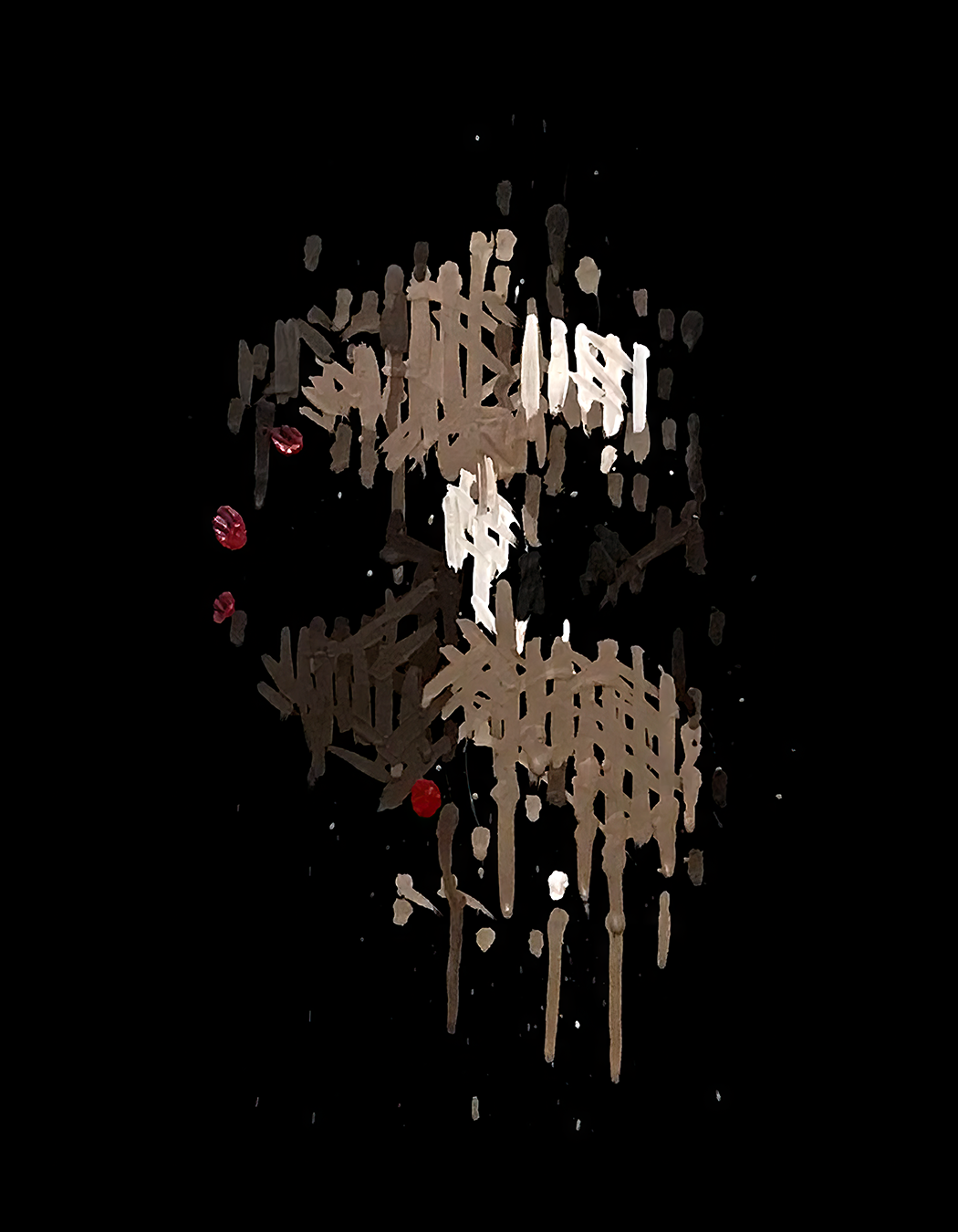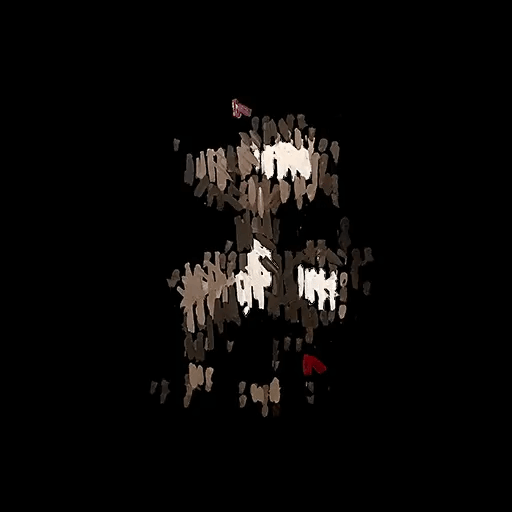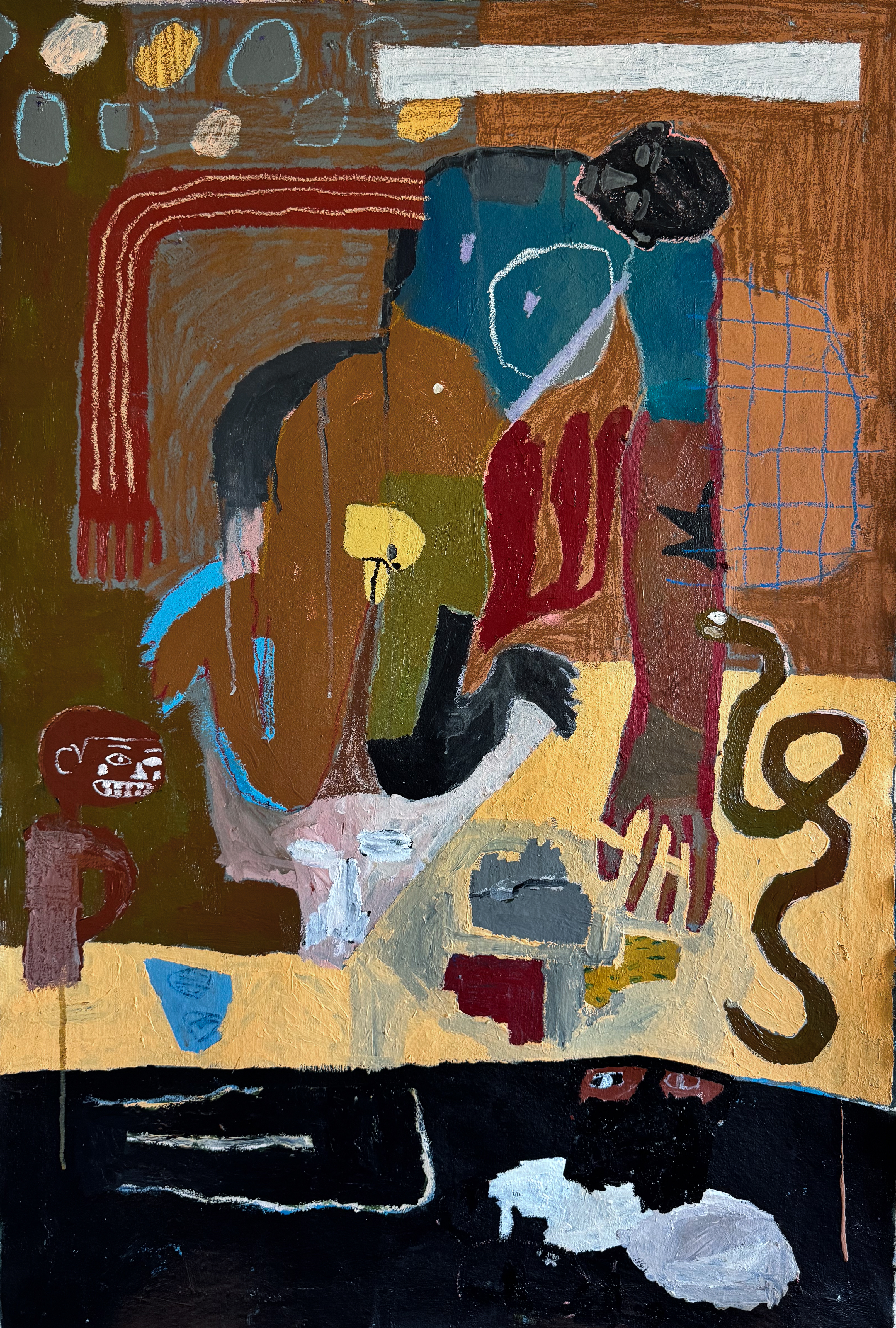About the artist:
Pindar Van Arman, an American robotist and artist, is largely interested in the exploration and interplay between human and computational creativity. Over the past two decades, he has been designing robots to paint with artificial intelligence.To take it a step further, Van Arman intricately trains his robots to emulate his personal artistic hand, engaging in a collaborative process to produce the artworks. His methodology involves incorporating feedback loops into the programming, enabling his robots to learn and evolve in order to self-analyze both their progress and mistakes. It is through these learnings and extensive experimentation, that has guided his continuous curiosity around the understanding of creativity as a dynamic interplay between emotion and logic. His hope is to study and understand how his robots might evolve, while referencing learned experiences, bettering their artwork over time accordingly.
This transformative approach not only reflects the evolution of artistic practices but also signifies a profound exploration of the synergy between human intuition and computational capabilities in the realm of imagination. At the heart of his endeavors lies the ambition to challenge and understand the fundamental notions of creativity, particularly in exploring how a robot, for example, might achieve independent thought and convey emotion within an artistic composition. Raising questions around our understanding of free will, the dichotomy between the left vs. right brain, and the dynamics of experiencing, comprehending, and potentially creating artwork that evokes emotional responses in the viewer's mind.
Grounded in his distinct artistic approach, he continues to research emotion from both a creative and analytical perspective. As his robots evolve, so does in turn his own hand painted works in parallel. Creating a ripple effect, not only representing the evolution of his robots paintings, but his own through his learnings. Each new mark is dependent on the emerging artwork and all the marks that came before. The multimedia work he creates are artifacts of his true medium, which is machine-collaborative creativity, his artistic process codified.
About the Project:
The First Sparks of Artificial Creativity, by Pindar Van Arman, comprises a captivating collection of 128 artworks, each accompanied by a compelling backstory. In 2018, Pindar generously distributed 128 physical paintings on 16”x20” Stonehenge Archival Paper at a conference in New York City called “Views.” At the time, these physical pieces included a cryptographic signature on the bitcoin blockchain, serving as certificates of authenticity for each of the physical artworks. To date, only a limited number of those physical paintings distributed during the conference have been confirmed to still exist, and none of the corresponding cryptographic certificates of authenticity were ever claimed.
Now for the first time Pindar is unveiling these works in their digital form with AI enhancements as a 1/1/128 series on SuperRare. The metadata of each digital artwork will include proof of the original unclaimed cryptographic certificates of authenticity from the bitcoin blockchain related to the 2018 physical works.
"These are images of faces emerging from the darkness as AI emerged from darkness, the first sparks of mechanical imagination, artificial creativity recorded at the time it was born." - Pindar Van Arman
Auction Details:
- 128 Works
- 1 ETH Each, First Come First Serve
- Available for up to 1 week
- After 1 week, any unminted will be locked in Pindar’s collection for the next 5 years before becoming available again.
- Artworks will be revealed after mint out or once the 1 week period expires.
To incentivize secondary sales on SuperRare and protect his royalties, once the primary mint has concluded Pindar will be offering the first 50 collectors who list and sell one of these works on SuperRare’s secondary market (for a price equal or greater to mint price) a signed physical print/physical painting.
The Interview:
1. Paloma: How would you describe the robots as they relate to you as the maker and you as an artist?
Pindar: My robots are the ultimate studio assistants. Almost twenty years ago they began by painting backgrounds that I would touch up and finish. At first all they did was connect-the-dots and paint-by-numbers, like an over engineered slow printer. Every couple of months, however, I would improve their algorithms and have them help with increasingly complex tasks.
The biggest breakthrough was after about five years into the project when I gave the robots eyes with a camera and had them build upon their own progress. This integration gave them the ability and taught them to reflect. Subsequently, around six years later, Deep Learning Neural Networks came into maturity and I used it to teach my robots to paint with imagination.
The first projects back in 2017-2018 focused on imagining and painting faces. I made a couple hundred paintings across multiple different series. In each series, my robots would imagine faces and paint them, experimenting with different approaches. One of the series was called “AI Imagined Portraits”, another “Emerging Faces”, and the one that I am currently releasing with SuperRare was “The First Sparks of Artificial Creativity”.
Though similar, each of the series had subtle differences both in how they looked as well as how they were painted. The “AI Imagined Portraits” were larger paintings and some of the first 1/1 tokens I minted on SuperRare. Meant to be seen individually, these faces were painted by the robots until their facial recognition software identified a face on the canvas, at which point they stopped painting.
AI Imagined Portrait Painted by a Robot #2, 2018
One of these works which was one of the earliest works on SuperRare, titled “AI Imagined Portrait Painted by a Robot #2,” garnered attention and recognition, being acquired by the Los Angeles County Museum of Art (LACMA) for their permanent collection in 2022.
A second similar but different collection was the Emerging Faces series on SuperRare. These were meant to be seen as sets and once again explored how early a face being imagined by AI could be recognized as a face. They all exist right on the fine line of being random strokes on canvases and a face.
“The First Sparks of Artificial Creativity” continued exploring the theme, while also exploring variation in how the AI painted the same face. Where it differed from the earlier series is that it would then paint the same face repeatedly experimenting with different brushstrokes. Hundreds upon hundreds of faces were painted on Archival Stonehenge Paper. The experiment took over my studio and then my house as I refined how the robot planned and executed a painting.
When I was done experimenting I selected my favorite 128, and labeled and numbered them. Instead of minting them, however, I recorded images of each on Certificates of Authenticity that were cryptographically signed on the BTC Blockchain. To be clear, these certificates were not NFTs, but rather a cryptographic record that the physical artwork existed at the time I created the BTC timestamp. I then gave the paintings away at a conference called Views in New York City where I also provided directions to claim the cryptographic signatures to anyone that was interested. But in a story we have all heard before, not a single certificate was claimed.
“The First Sparks of Artificial Creativity” as I am releasing them, more than 5 years after giving away the physicals, are AI enhanced versions that include the original cryptographic signature and provenance from 2018. Each includes a photo of the original physical and its hash that can be compared to the Merkle Root on BTC Block 536,744 to prove that the photo’s hash was used to help calculate that Merkle Root, and therefore must have existed at the time.
These are images of faces emerging from the darkness as AI emerged from darkness, the first sparks of mechanical imagination, artificial creativity recorded at the time it was born.
2. Paloma: What guides the emotional side of the work while being created in terms of a creative understanding vs. the analytical and procedural?
Pindar: I like to say that my robots paint with a combination of creativity and logic, guided by reflection. Think of it as a right-brain / left-brain duel. My AIs creative side utilizes deep learning neural networks to be expressive and do something remarkably close to imagining. Its analytical side uses purely procedural AI to measure characteristics like contrast, and then based on an analysis of the measurements, improves it. The AI goes back and forth between creating and refining as a new artwork emerges.
How does it know whether it should be creative or analytical?
It has cameras watching its own progress. The entire time it is painting, it is reflecting on how to make the artwork better and whether the improvement needs to be emotive or technical. As stated earlier, my robots paint with creativity and logic, guided by reflection.
3. Paloma: Can you tell me about the significance behind the drip in the artworks?
Pindar: The drips have many purposes. They are stylistic, emotional, and even practical. Stylistically, I just think they look cool. They give the painting both a street art vibe and a painterly base. At first glance you immediately know they are paintings, because there is all this paint dripping down on them. Emotionally, they evoke tears, and lend a solemn sadness to the pieces, especially portraits. But the most interesting aspect of them is their practical purpose. My robots are watching the artwork that emerges on the canvas, and trying to make the canvas look more like the image in its memory with each stroke. So when it sees a drip, that goes into the calculus of what it should do next. Sometimes it repairs them, other times it accentuates them.
The drips are the serendipity born of chaos theory that adds true randomness to the robots internal generative algorithms. Some procedural art generates random numbers to achieve greater variation. My robots use a variety of unpredictable elements, such as the drips, to incorporate true randomness into the art.
4. Paloma: You once said that there could be this argument made that all art is generative? Can you tell me a bit more about what you meant by this?
Pindar: Over the years, I have seen multiple Jackson Pollock inspired robots that dripped paint on a canvas, one of which was remarkably good. This led me to realize that its creators had recognized and codified Jackson Pollock's creative process. For example, in his popular Black and White paintings, he alternated dripping black and white paint in equal quantities until a canvas was covered by the dripped paint. This exact algorithm has been successfully replicated by robots.
Then I thought about how most artists have a look and process by which they create art. It is not difficult to imagine this process as an algorithm that the artist executes over and over again to get their signature look.
And this is what Feedback, my latest AI system, is all about. It is my attempt to codify my artistic process, to capture its essence. As I get closer, and the AI becomes more powerful, I become increasingly convinced that all the art I make might be generative. This is because if a generative AI system can replicate my creative process, that is strong evidence that the creative process itself is generative.
5. Paloma: You raised this question of free will. I wonder in your opinion, how can we understand what it means to be creative or to be an individual with emotions? Furthermore, how does this relate to what you are hoping to question throughout your body of work?
Pindar: This absolutely builds on the growing suspicion that I just mentioned, that all art is generative. As humans we like to think about what separates us from the rest of the universe, what makes us special. A popular answer is that our creativity sets us apart from all other creatures and things.
So here is the rub, and something that bothers me more and more as AI advances. If creativity can be achieved by machines, and they are achieving it, does that diminish our importance? Also does that mean that creativity is deterministic, as currently, all machines are deterministic? Meaning while we think creativity comes from some sort of divine inspiration, maybe it is just a complex algorithm that given the same inputs will always provide the same outputs - like a generative art piece working off an algorithm. And if this is the case for creativity, what we understand to be one of our most human traits, does this mean that all our decisions from what to eat to who we love is predetermined?
In short, is every decision we make predetermined by algorithms being executed by the biochemical machine that is our brain? - Pindar
Is Free Will an illusion?
I am not there yet. But there is a surprising amount of clinical evidence that we are just riding along with our bodies as it does whatever it is going to do, regardless of what we tell it. In this way our lives might be more of a movie, than a choose-your-own-adventure.
I guess that by trying to capture my own creativity in code, I am searching for evidence that I do in fact have Free Will. The humanity of my art is where my algorithms fail, what it can not do and replicate. There are of course still creative things that my robots can not do, and I hope will never be able to do. I see these specific things as the line that separates humanity from the inanimate.
As I say this, I am also open to the possibility that there is no limitation to the amount of humanity attainable by artificial intelligence.
6. Paloma: Since 2018, how has the concept of the feedback loop, integral to the creation of the final artwork, been shaped by the external feedback loops that you engage with?
Pindar: Feedback Loops sounds technical, but I first heard of it from painter Paul Klee. He described the creative feedback loop as the process by which an artist makes a mark on the canvas, then takes a step back to examine the mark, and uses the analysis to make the next mark, over and over again in creative feedback loops.
This happens throughout each artwork I make with my robots as it reflects on each mark, but it also happens externally, outside the artwork. Each successful artwork and each failure influences the next.
My art was very different before I began teaching my robots to paint. As I broke down the various processes I used so I could turn them to code, I was forced to reflect on why I did some of the things I did. And this reinforced my style, as I realized exactly what my style was. But beyond this, things would happen unexpectedly and go in directions I wasn’t expecting.
One example I can think of is that I realized that many of the strong artworks that we were creating had two dominant colors and one accent color. Over the years this accent color kept repeating itself as a bright lime green, and it grew to become part of my style. I didn’t intend for it to, but since I was using successful artworks to teach my robots how to paint more successful artworks, small elements that appeared in previous works started making reappearances, this color as an accent being one of those elements. In this way my robot style has influenced mine.





